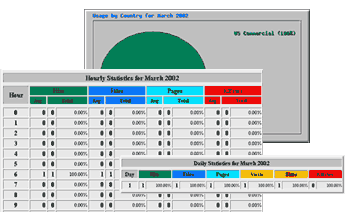Web
Statistics:
You may view your hits statistics for your website in
the section. You will be able to view the following:
- Your website's monthly visitors access
summary.
- Your website's daily visitors access
summary.
- Your website's hourly visitors access
summary.
- Your website's access
by country.
- The most accessed file on your website.
- The most bandwidth consuming file on your website.
- The webserver responce code. (eg. error 404, file
not found, etc.)
Yearly
Summary:

The yearly (index)
report shows statistics for a 12 month period, and links
to each month.
Monthly Summary:

The monthly report
has detailed statistics for that month with additional
links to any URL's and referrers found. The various
totals shown are explained as below.
Hits:
Any request made to the server which is logged,
is considered a 'hit'. The requests can be for
anything... html pages, graphic images, audio files,
CGI scripts, etc... Each valid line in the server log
is counted as a hit. This number represents the total
number of requests that were made to the server during
the specified report period.
Files:
Some requests made to the server, require that
the server then send something back to the requesting
client, such as a html page or graphic image. When this
happens, it is considered a 'file' and the files total
is incremented. The relationship between 'hits' and
'files' can be thought of as 'incoming requests' and
'outgoing responses'.
Pages:
Pages are, well, pages! Generally, any HTML
document, or anything that generates an HTML document,
would be considered a page. This does not include the
other stuff that goes into a document, such as graphic
images, audio clips, etc... This number represents the
number of 'pages' requested only, and does not include
the other 'stuff' that is in the page.
Sites:
Each request made to the server comes from
a unique 'site' (or person), which can be referenced
by a name or ultimately, an IP address. The 'sites'
number shows how many unique IP addresses made requests
to the server during the reporting time period. This
DOES NOT mean the number of unique individual users
(real people) that visited, which is impossible to determine
using just logs and the HTTP protocol (however, this
number might be about as close as you will get).
Visits:
Whenever a request is made to the server from
a given IP address (site), the amount of time since
a previous request by the address is calculated (if
any). If the time difference is greater than a pre-configured
'visit timeout' value (or has never made a request before),
it is considered a 'new visit', and this total is incremented
(both for the site, and the IP address). The timeout
value for our servers is 30 minutes, so if a user visits
your site at 1:00 in the afternoon, and then returns
at 3:00, two visits would be registered.
KBytes:
The KBytes (kilobytes) value shows the amount
of data, in KB, that was sent out by the server during
the specified reporting period. This value is generated
directly from the log file, so it is up to the web server
to produce accurate numbers in the logs (some web servers
do stupid things when it comes to reporting the number
of bytes). In general, this should be a fairly accurate
representation of the amount of outgoing traffic the
server had, regardless of the web servers reporting
quirks. (A kilobyte is 1024 bytes)
Top
Entry and Exit Pages: The Top
Entry and Exit tables give a rough estimate of what
URL's are used to enter your site, and what the last
pages viewed are. Because of limitations in the
HTTP protocol, log rotations, etc... this number should
be considered a good "rough guess" of the
actual numbers, however will give a good indication
of the overall trend in where users come into, and exit,
your site.
Country:
The country Statistics is shown in the form of a Pie
Chart. This report displays in percentage the number
of users from a particular country. This information
is derived from the hostname of the visitor's computer
when accessing your website.